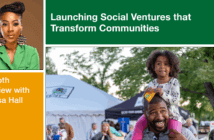Congregations, particularly mainline and established congregations, commonly tell either safe or weak stories about themselves. In an earlier era, when identity and purpose were clearer for many congregations, stories could be bold and have the strength of pride: “We are the Methodist church in town.” “Our Unitarian church was founded by descendents of original Pilgrim families and has always been located here on the town green.”
A central task of the narrative leader is to learn deeply about the people and the history of the congregation and, when they are found to be limited by weakness and are retreating to safety, to be able to tell the people stories that carry the message, “You’re better than that.”
Weak Stories
Today many clergy are still called or appointed to — and many lay leaders inherit — congregations with weak stories that are products of a remembered past that had position and resources. Some leaders still wrestle with the memory of the sanctuary filled every Sunday, while they now measure the increasing distance between fewer worshipers who scatter themselves across the pews in the same sanctuary. Many congregations tell their stories using measurements of how many people used to attend, how many programs they once had, how they once did mission using the resources from an over-subscribed budget. They also “remember” how their clergy once knew everyone in the church, were well known in the community, and never preached a bad sermon.
Telling a weak congregational story does not depend upon having a shrinking membership or inheriting a changing neighborhood. A strong, vital, and large congregation today can still tell a weak story. With hundreds in attendance, multiple programs, and growing staff, it is nonetheless possible to live out of weakness as a story is told of community needs too large for the church to address, community issues too complex to lend themselves to change, and … there is always a larger church up the street better equipped.
Safe Stories
If many congregations have learned to tell weak stories, many more tell safe stories. Safe stories are the ones people tell themselves that are true but incomplete. A safe story is about how warm and friendly the congregation is. What is incomplete is the rest of the story about how stiff and formal members are with visitors while being warm and friendly with the folk who attend regularly. What is safe is the story of how the congregation was once a neighborhood church that had the gift of including people from each new immigrant wave that washed into its neighborhood. What is incomplete is how members now feel distant and distrustful of the new people surrounding the church who seem so different from them. We collude not to tell the rest of the story that will make us uncomfortable.
Safe stories may be even more difficult for a congregation to live past than weak stories, because safe stories are self-shaped and self-imposed. Novelist and philosopher Iris Murdoch suggests that people commonly live out of a distorted perception of themselves, which might be thought of as a “safe middle.” She suggests that we present our safe middle to ourselves because it is a true though incomplete reflection, and it is comfortable for us to live with. What is missing from the safe-middle identity on one side is the darker side of our limitations, our problems, and our challenges, which feel too risky for us to acknowledge publicly. If we included our darker side in our descriptions of ourselves, we would actually have to do something about them. What is also missing from the safe-middle identity on the other side is the stronger side that includes our gifts and our talents. If we name our gifts and talents, we would actually have to use them and be accountable for them.
A Better Story
A central task of the narrative leader is to learn deeply about the people and the history of the congregation and, when they are found to be limited by weakness and are retreating to safety, to be able to tell the people stories that carry the message, “You’re better than that.” Howard Gardner, author and Harvard professor of education, in his writing about leadership describes a central task of leadership as giving the people a better story to live by. (Leading Minds, 1995, 9-11)
Giving people a better story to live by is not an invention of a new tale to tell about themselves, not a Pollyannaish telling of what isn’t. In fact, telling a better story is an act of leadership because it tells a true story of the people that is different from the safe way in which they choose to tell their own story. Such telling, for the leader, is risky. This kind of storied leadership challenges the weak or the safe story that has been chosen in the past simply because it has been so comfortable and undemanding. Narrative leadership risks telling a new and different story that will disrupt established harmonies and entail costs even though it is an effort at faithfulness.
Reprinted from Finding Our Story: Narrative Leadership and Congregational Change edited by Larry A. Golemon, with permission from the Alban Institute. Copyright © 2010 by The Alban Institute, Inc. Herndon, VA. All rights reserved.






